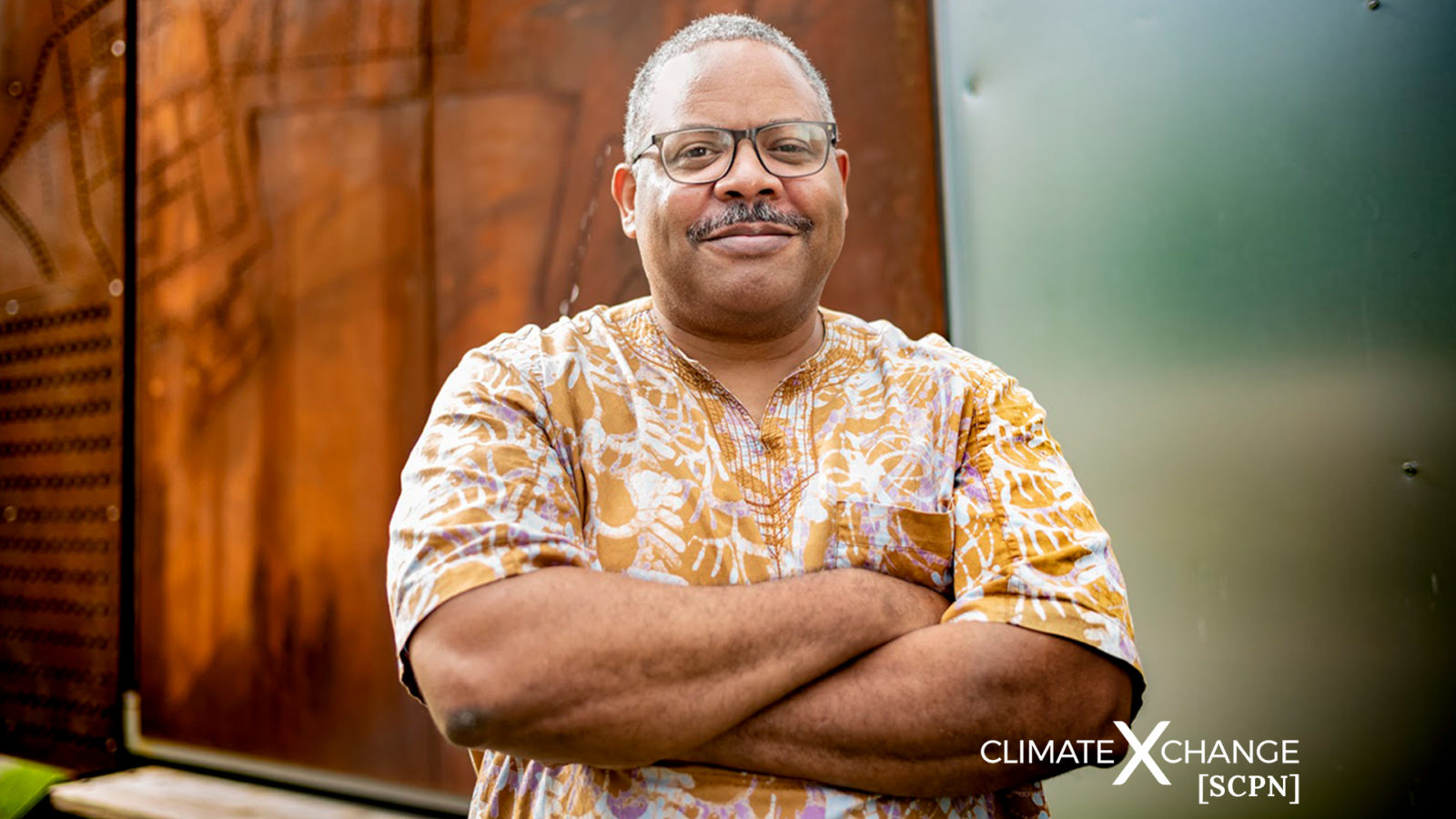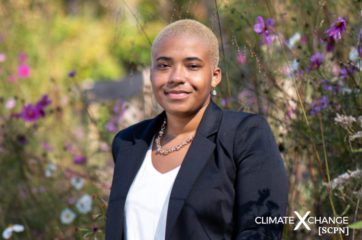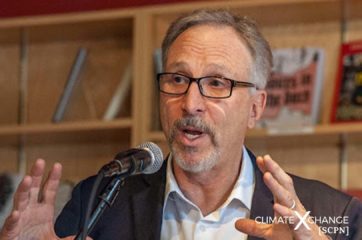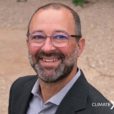All across the country, members of our State Climate Policy Network (SCPN) are fighting to make an impact on climate change in their communities. We have individuals in our Network from all 50 states, each experiencing climate change differently in their local areas and finding unique solutions to build resiliency efforts.
Kofi Boone is a University Faculty Scholar and Professor in the Department of Landscape Architecture and Environmental Planning at NC State University in the College of Design. He is a Detroit native and a graduate of the University of Michigan. Kofi’s work explores the intersection of landscape architecture and environmental justice with specializations in democratic design, digital media, and interpreting cultural landscapes.
Ava Gallo
Thanks so much for taking the time to speak to me today! Let’s just start broadly with a brief overview of your background.
Kofi Boone
Sure. My name is Kofi Boone. I am from Detroit, Michigan. I went to University of Michigan for my undergraduate degree and a master’s degree in Landscape Architecture. I worked professionally for 10 years at a big firm called SmithGroup working on a lot of projects largely in the Midwest related to community engagement, urban planning and design, and landscape architecture.
Since 2004, I’ve been teaching at NC State University in Raleigh, North Carolina, and a lot of my work deals with the overlap between environmental justice and landscape architecture. Contemporary contexts have been more centered on climate justice and how to prepare for the changes to come through design in equitable ways.
Ava Gallo
Can you elaborate more on what you think the intersection is between environmental and climate justice and landscape architecture?
Kofi Boone
That’s a great question, and there’s a lot. Where I’ve spent some time is trying to center environmental justice communities in the decision making process about what happens in their neighborhoods. Landscape architecture trains you to work through a lot of different things. We have a lot of technical expertise, but sometimes because of the nature of what we are working on, some of the people who are most affected, particularly frontline communities, do not have as strong of a voice as they need to have to actually address some of these challenges. So the environmental justice side of the game is trying to find ways in the design process to empower those people and those voices so that they are visible, seen, heard, and affecting the decisions that affect them.
On the other side is the technical component which entails communicating to landscape architects that there is plenty of room to innovate as we take on these challenges. Where I mainly spend my time is trying to amplify and elevate the voices of Black and brown people who are dealing with these climate challenges head on.
Ava Gallo
Thinking about community engagement and democratically designing projects, can you talk about the role that storytelling plays in climate planning and increasing resilience to climate disasters.
Kofi Boone
It’s a huge role. First of all, no one knows their communities better than the people who live there, and it’s usually only in a crisis or a confrontation that people are asked to stand up and tell their story that aligns with the goals of the project being presented. People are expected to bubble up and be generous with their views on it. What we’ve tried to do is say that the storytelling matters. It’s the most effective way of passing information. People understand stories more than they understand this litany of technical information.
It unveils positive things in the community that don’t usually show up when outsiders come in with a problem-focus. So we come in asking: what is so great about this community, why do you love it so much, what are some things that inspire you? It changes the nature of the conversation and gets it off just problems and on to how you amplify and expand assets.
I think that the last part is that it helps to reframe the problem. In design that is one of the first steps. What focusing on stories and narratives does is make us question what problems we are actually trying to solve here based on the lived experience of people facing these challenges.
Narrative plays a lot of roles. In design, we rely on visual narrative often, the ability to tell those stories with pictures. Some of the damage that has been done in these communities from prior policies is difficult to communicate in words. But images of what communities were before disastrous changes occurred can really help communities make decisions.
Ava Gallo
Yes exactly! I think that we have seen this a lot. I’m in Boston, and we just had a situation on Melnea Cass Boulevard, there was a plan to create a bike lane on that road. That seems on its face like a really great project, but the plan was to cut down all of the trees that were along the road. That created immediate backlash in the community of Roxbury that already has a lack of consistent tree canopy. Which demonstrates that idea that the community knows best what it needs, the problems it’s facing, and the good things that already exist, which is hard to know if you are an outsider coming with preconceived notions.
Kofi Boone
It is a shame that something like a bike line can be so controversial, but it’s not specific to Boston. It’s everywhere, from the removal of on-street parking, which is what we’ve dealt with here. As designers and planners, we have this utopian vision of, “Oh, they can just walk or bike to work.” But when you start to look at environmental justice communities where employment and wealth is a challenge, and people have to drive long distances that aren’t connected to transit to get to their job. You start to look at the value of what other people say that a bike lane provides: decarbonization, health, exercise, but the reality of the necessities of people’s lives don’t align with the strategies we would normally use as troupes is real all over the country.
Ava Gallo
Thinking about needing to get out of the policy troupes and getting more innovative thinking in landscape architecture like you mentioned, this year you are teaching the Green New Deal Superstudio. Can you talk more about what that program hopes to accomplish?
Kofi Boone
Sure. I am on the board of the Landscape Architecture Foundation, and one of our initiatives this year is the Green New Deal Superstudio. It started out of an idea that came from Billy Fleming at the McHarg Center at the University of Pennsylvania to give policymakers a way of understanding the potential positive impacts that landscape architecture has to play in advancing the three sub themes of the Green New Deal Superstudio: decarbonization, environmental justice, and jobs.
The Green New Deal, of course, comes from the resolution from Representative Alexandria Ocasio-Cortez that talked about borrowing the lessons from the New Deal in the Roosevelt administration in activating our government to rebuild our infrastructure. If we are going to do that now, we can point that effort to getting off of fossil fuels and empowering communities for the first time to make a transition to a clean economy. It requires a scale of impact that we haven’t seen since the New Deal.
It is very politicized, and I will say up front that in the South the Green New Deal is not a popular term. In some cases, it is a turn off. But demonstrating how the sub themes of decarbonization, environmental justice, and clean jobs would benefit communities is popular.
The Superstudio started in the fall and is a connection of multiple studios. Right now we have over 150 studios with about 2,000 people around the world working on projects in their own backyard where they can visualize the potential positive impacts through the landscape. We’ve got a multidisciplinary studio here at NC State with 17 students and a lot of excited local people. So we’ve been busy!
Ava Gallo
What have been some of the specific projects that have come to light in your studio for North Carolina?
Kofi Boone
We are focusing on the city of Charlotte, which is the largest city in North Carolina and one of the fastest growing cities in the country. As far as cities go, it is one of the most complete, meaning that you get a range of densities, it has light rail, and is the only city in North Carolina that has public transportation.
What we are looking at is a historically Black community that is between the airport and the downtown that is going to grow rapidly in the near term. There is a light rail line that is being proposed to connect this neighborhood to other systems. We are looking at the potential for an equitable transit-oriented development that also works to reduce greenhouse gas emissions. We’re trying to think creatively about job creation and center the interests of the community in all of the decision making. We’re going through some of the preliminary work right now, and we kick off in about 10 days.
Ava Gallo
Wow! That sounds like a really exciting project.
Kofi Boone
We’re hopeful! Because of COVID-19, it is challenging to do authentic community engagement. But we’ve identified an advisory group that is willing to work with us. The site right now is accessible, so it is not a problem getting out to it. Many of our students have actually never been to Charlotte, so it will be an introduction to a totally different part of their state.
Ava Gallo
I want to transition a little bit through the discussion of Charlotte into your piece, “Black Landscapes Matter.” Can you discuss the impetus for writing the piece and walk through the eight propositions at the end of the piece?
Kofi Boone
Several years ago, I got a call from a good friend, hero, colleague, Walter Hood, who is a leading landscape architect in the world. He wanted to convene a symposium at UC Berkeley, called “Black Landscapes Matter” on the anniversary of the insurrection that occurred following the Rodney King decision, which was my generation’s Black Lives Matter movement. People were really upset, particularly in South Central Los Angeles, when police officers beating a Black man were all acquitted even though the whole world saw the video. The world erupted.
So in a way, Walter was measuring our time and our distance from then to now, which was about 3 years ago, before the events of this summer. A number of us went to Berkeley, and the student journal at Berkeley asked if they could publish the talk I gave, and I agreed. As an academic, I didn’t even think about it. I thought it would sit on a shelf and disappear, but tragically, due to the killing of George Floyd, people were trying to find agency in terms of what we could do in the landscape space to address some of these deeply entrenched issues.
In short, what the talk was about was taking a framework that was provided by the founders of the Black Lives Matter movement, particularly these ideas of being seen, living with dignity, and being connected, as prime drivers to move society forward. Being seen referenced all of these experiences that we have every day that are not visible, not referenced. In the Black Lives Matter movement’s case, they are talking about serial murder of unarmed Black people by the police. In the case of my article, it talks about these landscapes that were integral to American history that Black people have played critical roles in creating that have been ignored.
In terms of dignity, I joke around, but I grew up in Detroit, and dignity was not really a word I heard a lot growing up, but in the South it’s a big deal. Even if you don’t have a lot of income or status, you carry yourself with a sense of pride and self-worth. In regards to landscape architecture, we think about places we have made that allow Black and brown people to feel affirmed.
That led to eight propositions that talked about revisiting our history in landscape architecture and including contributions from enslaved African people who played critical roles in our landscapes that we take for granted. We need to rethink how we teach it.
I have to say I’m still shocked that anyone ever read it, because usually when we write no one ever reads it. I’m really glad that people read it!
Ava Gallo
One of the stories that caught my eye in the piece was about Charlotte, with the example of the Second Ward, a thriving Black neighborhood that was displaced by the creation of new parks bearing the name of Black heroes and artists. Can you talk more about these unintended consequences of investments in public infrastructure that can harm people of color?
Kofi Boone
In Charlotte, like in a lot of American cities during urban renewal, there were a lot of decisions made that affected Black communities. In a global sense, cities were fighting to stay relevant in the context of the Cold War. After World War II, through the Federal Highway Act and the Housing Act of 1937, there was an intentional effort by the country to decentralize the United States for fear of nuclear annihilation. There was federally funded growth of the suburbs.
Cities were in a position of trying to stay relevant in the context of this decentralization. The federal government proposed that cities could classify areas as “slums” and receive money for redevelopment.
In Charlotte, they took this idea and redoubled on bias and racist policies that designated low-income communities, particularly Black and brown, as slums. Once you were declared a slum, that was it. There was no reinvestment. It was cleared and started over. That happened in Charlotte in one of its historic African American communities, the Second Ward.
Romare Bearden is one of the most famous artists from the Harlem Renaissance, and he grew up just outside of the city of Charlotte. One of the most famous redevelopment projects is Romare Bearden Park, which is steps away from an urban renewal area where the historic Black community was labeled a slum and destroyed.
Nationally this is an issue. It’s great that our country is interested in reinvesting in cities again. Because of this disinvestment, very vulnerable populations that needed low rents and easy access to the center of cities migrated to those areas and were not prepared for the switch in perspective that now values living close to the center of the city. These communities are now stuck in the middle of this. They don’t own the property, don’t have access to capital to invest, and are being displaced. Gentrification is a cycle that all cities face, but it doesn’t require removal of existing populations. And we have not figured that out yet.
Charlotte illustrates this well. It is great that they acknowledged one of the great artists in American history who was a resident of the area. But it is a shame that the Black community, who was particularly connected to that individual, can’t afford to live anywhere near it.
Ava Gallo
So the question really is: how can we make communities adapt for climate change, make them more green, and experience the benefits of a healthy environment without subjecting them to displacement?
Kofi Boone
That’s right. It’s going to be a challenge. What makes it difficult is how little of property, particularly in the center city, that Black and brown people own. My hometown of Detroit is a good example. The majority of vacant land and buildings are not owned by anyone in the city of Detroit. They are on the speculative real estate market that is global.
The barrier is finding ways for local communities to exert more control on property that they don’t own. Another solution is finding ways for local communities to actually acquire property. In my seminar this semester we are talking about the legacy of cooperatives and community land trusts. In Boston, you have Dudley Street Community Land Trust, which is one of the best examples of this.
Within that structure of collective, communal ownership, you can set your own rules and enforce affordability. But the bigger conversation is how to combine forces to exert local control in the scope of global economic forces. I don’t know if anyone has figured it out yet.
Ava Gallo
I want to bring it to the present day. We finally have executive action on climate change through President Biden’s executive orders. If you were called on the phone by President Biden or National Climate Advisor Gina McCarthy what would be the one thing you would urge them to think about or include in their new climate plan?
Kofi Boone
Wow, that’s the million dollar question. First of all, I’ll complement some things that I’ve read so far that they are doing. One thing that I do like is the inclusion of a racial equity lens for all of their decision making processes. If they can conduct an assessment and see that business as usual is negatively affecting groups of people, it draws attention to make changes.The other thing I saw was designating 40% of federal investment to frontline communities. So there are procedural changes and then a financial commitment, and together I feel very positive about that.
I think there are other issues though. If they asked me, I would say that capacity building of communities needs to be emphasized. An example is in many communities they don’t know when changes are going to occur until the agencies or the developers are required to share them. In the case of the private sector, it is when you have a site plan review.
Usually when you are at the point of a site plan, you have invested several years looking for financing, retaining designers and technical experts, done a market analysis, etc. So there is around 3 years of front end work that no one ever sees. By the time that you see the site plan, you can critique it, but there is not really much that will change.
Increasing the capacity building of communities requires enhancing transparency in the planning process. It works on the private market side but on the agency side as well. For example, part of the National Environmental Policy Act (NEPA) requires a social impact assessment of development, but it doesn’t currently carry a lot of weight. The environmental impact assessment is very detailed and is heavily weighted in the decision making. The social impact assessment is not heavily weighted and the standards are really weak.
So if they called, I would find a really eloquent way of combining those two ideas.
Ava Gallo
Hopefully you get that call, and you can make those recommendations!
Just to conclude, I like to finish on a positive note. Although there’s been many critiques, I think that environmentalists and climate activists have been feeling this unfamiliar feeling of hope these past few weeks. What keeps you inspired to keep working on environmental justice and community empowerment in this moment?
Kofi Boone
That’s a really good question! The shortest answer is that I would probably be interested in it even if I wasn’t an educator or in landscape architecture. It is something that I am just personally inspired by. I don’t see the purpose of sticking with something if you don’t see hope.
Bringing it back to my profession, what I tell my students is that design is essentially a hopeful act, so when we go through these processes, they take a long period of time to do, to implement, to tell whether you are even making an impact. It’s a leap of faith when you are in any of these built environment professions. I think we are wired that way.
In this regard, what has been revealed in a short period of time is the ability of a new president making decisions to rapidly reset and reframe the issues that we have to address. We have not gotten into Congress yet, all the secretaries haven’t been confirmed, there are midterm elections in two years, so there are a lot of landmines. I appreciated the White House using their power of executive order to make progress right away.
This echoes back to President Clinton who signed the executive order creating the first mention of environmental justice in the purview of the Environmental Protection Agency. It has done a lot of good. Executive orders are not sufficient, but you need that foothold to leverage other legislative actions.
Ava Gallo
Thank you so much for speaking with me today. These lessons that you are sharing are really important for everyone to hear right now, to feel hopeful but remain critical and push the federal government to be more ambitious and more equitable.
Kofi Boone
Everyone has to stay vigilant, and the midterm elections matter. It’s not too early to think about what we are going to do in two years, because this is what has derailed previous efforts on climate. The election of a president is not enough. All that energy going into this past election needs to remain through the next two years to continue the momentum that is necessary.
Ava Gallo
We had Tamara Toles O’Laughlin on one of our recent webinars, and she put it best when she said, “If you’re tired, take a nap. January comes, and we begin again.”
Kofi Boone
I definitely agree!









